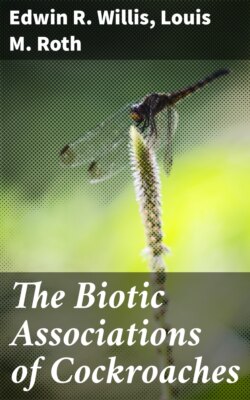Читать книгу The Biotic Associations of Cockroaches - Edwin R. Willis - Страница 300
На сайте Литреса книга снята с продажи.
Parcoblatta virginica
ОглавлениеNew England.—Females under loose stones, boards, and other debris on ground; beneath loose bark (Morse, 1920).
North Carolina.—Under debris in dead shortleaf-pine needles (Rehn and Hebard, 1916).
Florida.—Infrequent in the shrub stratum of the scrub habitat. This was the only habitat of 25 studied in which this species was found (Friauf, 1953).
Eastern and southeastern U.S.—Trapped in molasses-baited jars: in pine and oak woods, in pine barrens, in pine woods with heavy grass undergrowth, in oak forest, in heavily forested ravine, on rocky slope with few deciduous trees, on knoll with high deciduous trees, in lofty chestnut forest, and in heavy low chestnut and oak forest on high ridge; under bark of decaying chestnut log and stump; under stones in chestnut forest; under bark of pine stumps (Hebard, 1917).
Indiana.—Frequents borders of open woods and fields; under debris, loose bark, and half-buried logs (Blatchley, 1920).
Illinois.—In black-oak forest on sand, in oak-hickory forest on clay, and in climax forest (Strohecker, 1937).
Michigan.—Common in oak-dune and beech-maple forests; under loose bark on dead trees and fallen logs and under debris on forest floor (Hubbell, 1922). Restricted to woodlands, where it inhabited piles of moist dead leaves and rotten logs in oak-hickory forest (Cantrall, 1943).
Texas.—Captured in molasses traps in moist woods of maple, oak, and pine with much undergrowth and a heavy layer of duff; in open, rather dry woodlot of Spanish oak and other trees; and in low wet woods of willow and oak along creek (Hebard, 1943a).
